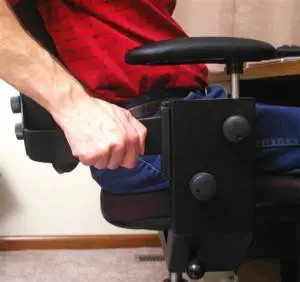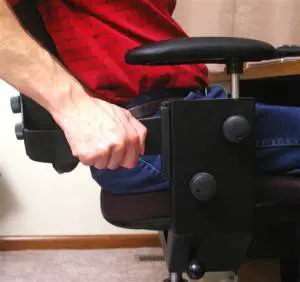Fidgeters of the world, rejoice! SmartMotion has made your perennial peccadillo into an ergonomic feature with the SwingChair – the chair that moves with you.
What’s a SwingChair and why am I reviewing it?
I have never before reviewed a chair on this blog, so why the SmartMotion SwingChair? Quite simply, SmartMotion contacted me on Twitter and we ended up agreeing to do a review. This is the first high-end adjustable chair I’ve ever tried out, so I can’t make accurate comparisons with any other popular brands. (Yet.)

Both the seat and back of the SwingChair tilt smoothly to follow your body motions.
According to SmartMotion, the SwingChair was developed by a guy who had ruined his back through the gentle art of wrestling. He found that no matter how a conventional chair was shaped, it eventually began to hurt his back by forcing him into one particular position all the time. It seemed logical that a chair should move with the occupant, and not just by a rocking-chair style “tilt” of the back. The seat and back should move independently and with easy fluidity – but without making the user seasick or dumping him in the floor.
The result of this theory is the SwingChair, a dynamic seating device which is a bit difficult to describe. Basically, the seat swings down when you sit in it, and up again whenever you shift your weight – same with the back. So when I lean down to grab a file from my drawer, the seat tilts forward and the back “follows” me. When I pick the file and lean back, the parts return to where they were before. The degree of tension in each dimension is adjustable to accommodate body weight, strength, and preference. The depth of the back can also be tweaked for different sizes. While the arms do not move constantly like the rest of the chair, they can be adjusted to unlimited rotation and height with two thumb screws.
Unboxing and putting it together

The back depth, back tension, and arm rest height/angle are adjustable via knobs on the side.
The Swingchair weighs in at fifty-six pounds, a fact I discovered after trying to lug its large box into the garage by myself. Though we had to buddy-lift it the rest of the way to my office (short pause while body builders recover from fit of hilarity) the heaviest single piece is small enough that I was able to put the whole thing together by myself. This operation took about ten minutes and – get this – required no tools, not even one of those Allen wrenches you lose shortly after opening the package. Everything on the chair finger-tightens using rubber grips. The only really challenging step was lining up the main piece with the seat post hole. The directions could be a bit slicker and more thorough, but I was able to get each adjustment figured out with no trouble.
My personal experience with the SwingChair
If you skimmed the heading to this section, please go back and read it again. What I’m about to share is my personal experience, not something that necessarily applies to others. In fact, I will next be sharing my brother’s experience, which directly contradicts mine. Got it? Great.
 When I first sat in the SwingChair, my notes were almost giddy with adoration: “One possible issue: This chair is so comfy I don’t want to take breaks….” Unfortunately, this private fan mail session came to an abrupt end on the second day, with the following glum admission: “I absolutely cannot use this chair – it makes my legs hurt.”
When I first sat in the SwingChair, my notes were almost giddy with adoration: “One possible issue: This chair is so comfy I don’t want to take breaks….” Unfortunately, this private fan mail session came to an abrupt end on the second day, with the following glum admission: “I absolutely cannot use this chair – it makes my legs hurt.”
It seems that the SwingChair cuts off circulation to my legs, and I have a fine guess why. When you sit in a SwingChair, the back of the seat cushion goes down and the front goes up – up as in, up into your thighs a few inches behind your knees. At first, I told myself that it couldn’t be true, but my own body said differently, transmitting the achy feeling my legs always get when circulation is compromised. Now I more fully understand why many office chairs feature “waterfall” style cushions that slope off gently to the front. And the SwingChair does too, to an extent – but the backward tilt of its seat makes that design element less effective.
I called SmartMotion and explained the problem. They are aware of some people having this issue, but they say that the number is very small. I’m glad to hear this, as I really like the design, and find it comfortable except for this one personal deal-killer.
Now for the good story
After deciding I couldn’t use the Swingchair, I loaned it to my brother Zach to try out. Neither he nor I really believed that he would like it, because, as he explains below, his problems with chairs and circulation are well-known and worse than mine. Still, it couldn’t hurt to try, right? No indeed. After ten days of using the chair, Zach wrote up his experience:
When Jason first asked me if I’d like to try out the Swingchair, I was a little dubious. He and I had previously bought identical Steelcase chairs, but I finally gave mine up because it cut off my circulation. Since this was the very problem Jason had with the Swingchair, I expected my trial period to be rather short. Well, ten days later, I’m still using it, thus proving that time-tested mantra of ergonomics: Everyone is different.
The Swingchair certainly struck me as comfortable when I first sat down – but first impressions with chairs are often wrong. I really liked the infinitely adjustable height of the arms, too, since my Steelcase presets were always just a little too high or too low. My first surprise from the Swingchair was that it was actually better for my circulation than the standard office chair I had been using for several months. When sitting in the Swingchair for long periods, I didn’t feel the need to change positions that I’ve always felt with other chairs.
Another Swingchair surprise was waiting for me at the end of the first full day of use. I found myself less tired than usual, without the slight neck and back soreness which often troubles me. To understand the reason for this, you first have to know that I am a chronic chair-edge-sitter. I do it automatically, unconsciously, throughout the day. I get up to walk around while I talk on the phone (Jason now tells me this is an advanced ergonomic strategy, but I’ve been doing it for years because it helps me think) and when I sit down, I don’t sit all the way back in the chair. Instead, I perch on the edge, a terrible habit that transforms the best ergonomic chair in the world into a five-wheeled piano bench. This lack of back support naturally leads to the above-mentioned neck and back soreness at the end of a long day.
Enter the cure for all the chair-perchers of the world: the Swingchair. You cannot sit on the edge of the Swingchair – you will fall in the floor. Thus, you have two options: stand up, or sit down with back support. If this ten-day trial is any indication, the Swingchair may be one of the best accidental discoveries I’ve ever made.
And there you have it. Incidentally, it’s been another three weeks or so at this writing, and Zach is as happy as ever with the chair.
This just in: Different things work for different people!
When writing about ergonomics, I find myself constantly reverting to the principle that different things work for different people. Really that’s what ergonomics is all about – what works for you, not some “expert” who wrote a guide. While the Swingchair doesn’t work for me, it does work for Zach – and it very well may work for you too. If it doesn’t, SmartMotion offers a 30-day money-back guarantee in addition to their 5-year product warranty. It’s well worth a try in my opinion, just to experience a chair that fidgets, er, swings with you.
Disclaimer: This review was made with a sample SwingChair from SmartMotion, which my brother later purchased at a special demo price.
- Your Complete Guide To The Best Ergonomic Kneeling Chairs - March 25, 2024
- 5 Best Ergonomic Wine Bottle Openers - March 4, 2024
- Handshoe Mouse Review - January 23, 2024




